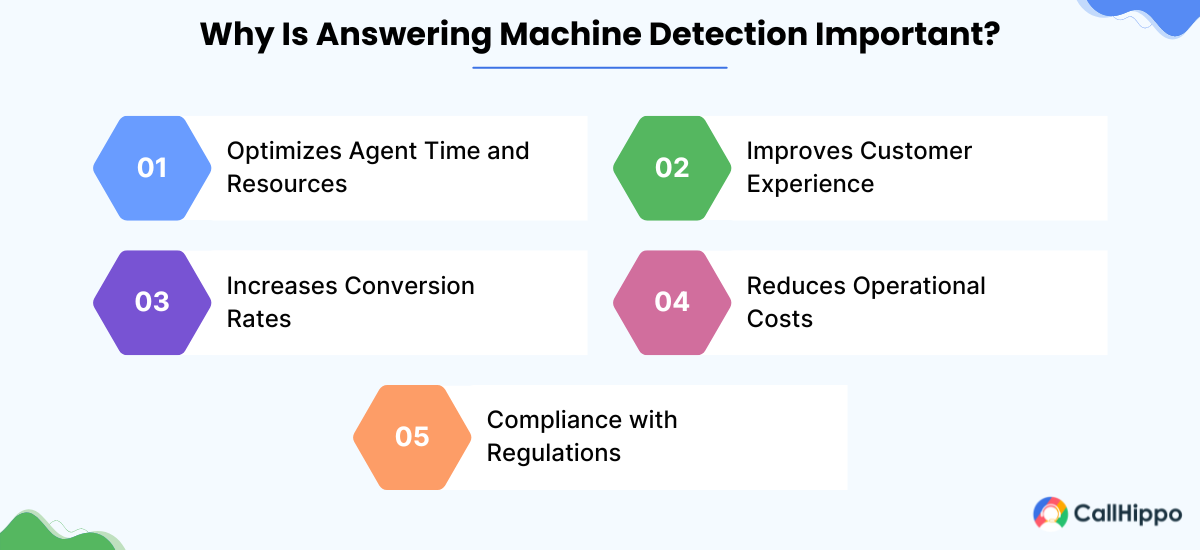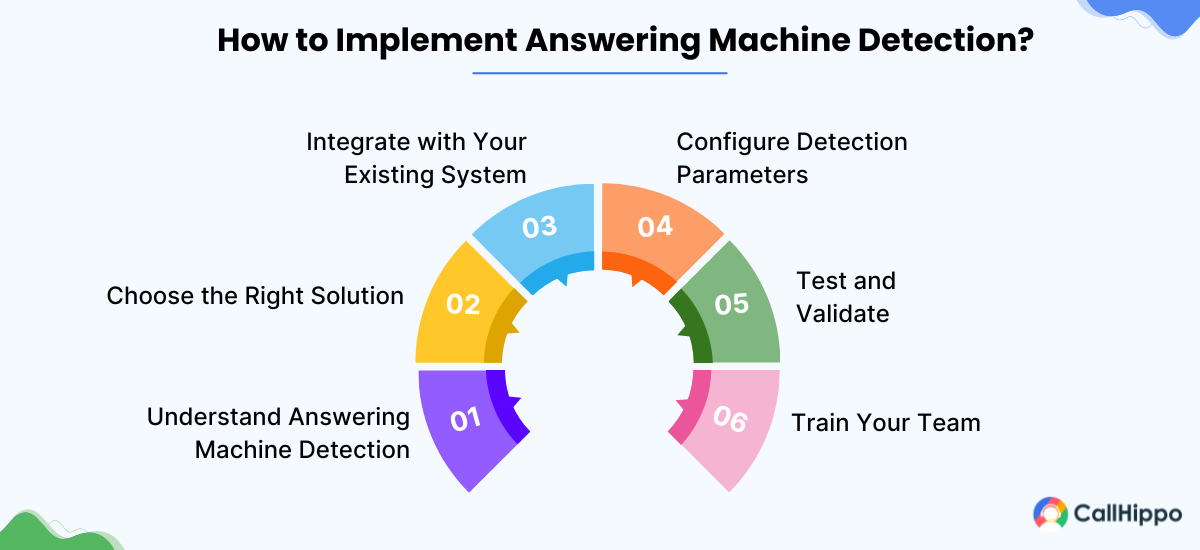When you are operating a call center where you have to make hundreds of calls every day, every second counts – quite literally. You cannot waste your time talking with the machine, right? You need a technology that helps you distinguish between answering machines and live human beings.
This is exactly what Answering Machine Detection or AMD does.
In this blog, we will discuss all the key aspects of AMD, including its definition, working, benefits, steps to implement, and more. Let’s get started without further ado!
Keep AMD algorithms updated regularly to ensure accurate detection, as newer answering machine technologies may emerge. Additionally, consider integrating AMD with other call center tools for enhanced efficiency and customer satisfaction.
What Is Answering Machine Detection (AMD)?
Automatic machine detection or voicemail detection is a smart technology used in call centers and automated systems to differentiate between answering machines and live human beings.
It works by analyzing audio signals and identifying patterns unique to answering machines, like pre-recorded messages. Once it detects an answering machine, it can either leave a message, prompt the caller to call back later, or connect to a human agent.
Now, the question is– why does it matter to know if you are talking to a person or a machine? Well, think about it this way: if you are a telemarketer or someone trying to reach a lot of people, you don’t want to waste time on answering machines. You want to talk to real people who might be interested in what you have to say.
So, answering machine detection helps these systems decide whether to keep ringing or to start playing a pre-recorded message. It saves time and energy for everyone involved.
How Answering Machine Detection Works?
As explained above, answering machine detection (AMD) is a technology used by call centers and automated dialing systems to determine whether a call has been answered by a human or a machine. Here’s how it works in four simple steps:
Step 1: Initial Call: When you receive a call from a telemarketer or an automated system, the system starts by playing a short audio message or silence.
Step 2: Listening for Patterns: The system analyzes the initial sounds and audio patterns in the first few seconds of the call to determine if there are indications of a human voice or an answering machine message.
Step 3: Decision Making: Based on the patterns detected, the system makes a quick decision about whether it’s human voice or answering machine. It takes into account factors like voice pitch, background noise, and speech patterns.
Step 4: Response: If it detects a human, it routes the call to an available agent. If it detects an answering machine, it may leave a pre-recorded message or hang up.
Importance of Answering Machine Detection
Based on the information covered in the previous sections, you should now have a clear understanding of the workings and benefits of an AMD (Answering Machine Detection) system. Let’s now look at the importance of an answering machine detection system.

A. Optimizes Agent Time and Resources
Answering machine detection helps call centers and businesses optimize their resources by filtering out unanswered calls or those answered by machines.
This means agents can focus their time and energy on engaging with live callers, addressing their needs promptly, and providing personalized assistance.
B. Improves Customer Experience
Suppose you are calling a customer but greeted by a pre-recorded message instead of a live agent. It can be frustrating, especially if your query is urgent or complex.
Answering machine detection systems or voicemail detection systems ensures that callers are promptly connected to a human representative. This led to quicker issue resolution and improved customer satisfaction.
C. Increases Conversion Rates
For businesses that rely on outbound sales or marketing calls, identifying live contacts is crucial for maximizing conversion rates.
Voicemail detection systems enable these businesses to differentiate between live answers and voicemails– allowing them to tailor their approach accordingly.
Agents can engage with live callers in real-time, address their inquiries, and capitalize on sales opportunities. This will lead to higher conversion rates and increased revenue generation.
D. Reduces Operational Costs
Voicemails and answering machines consume valuable resources, including agent time and telecommunications expenses, without yielding immediate results.
By minimizing the number of calls that result in voicemails or answering machines, businesses can reduce operational costs associated with wasted agent hours and unnecessary call attempts.
E. Compliance with Regulations
In some jurisdictions, regulations govern the use of automated calling systems and dictate how businesses must handle unanswered calls or calls answered by machines.
By adding answering machine detection into their telecommunication systems, businesses can mitigate the risk of non-compliance penalties and maintain a positive reputation within their industry.
Implementing Answering Machine Detection in Your Business
So now we are aware of what answering machine detection is and what its benefits are. Let’s now look at the steps to implement answering machine detection in your business:

Step 1: Understand Answering Machine Detection
Before you start the implementation of AMD, it’s essential to understand what answering machine detection is and how it works. Answering machine detection is a technology used in telephony systems to determine whether a call has been answered by a human or an answering machine. It analyzes factors like voice patterns, background noise, and timing to make this determination.
Step 2: Choose the Right Solution
You must note that there are various voicemail detection solutions available in the market, ranging from standalone software to integrated systems within a call center software suite. Research and compare different options to find the one that best fits your business needs, budget, and technical requirements.
Step 3: Integrate with Your Existing System
Once you have selected a suitable answering machine detection solution, it’s time to integrate it with your existing telephony system or call center software. Depending on the solution you have chosen, integration methods may vary. Work closely with your IT team or software provider to ensure a smooth integration process.
Step 4: Configure Detection Parameters
After integration, configure the detection parameters according to your business requirements. This includes setting thresholds for factors like voice pitch, duration of silence, and background noise level to accurately distinguish between human answers and answering machines.
Step 5: Test and Validate
Before deploying answering machine detection in a production environment, thoroughly test the system to ensure its effectiveness and reliability. Conduct test calls across different scenarios, including various types of answering machines and voicemail greetings, to assess the detection accuracy. Make adjustments as needed based on the test results.
Step 6: Train Your Team
Once the answering machine detection system is set up, train your team members efficiently on how to leverage this technology effectively. Provide them with guidance on interpreting detection results and adjusting their approach accordingly.
By following these six steps, you can successfully integrate answering machine detection into your telephony system and reap the maximum benefits.
How Accurate Is Answering Machine Detection?
The accuracy of AMD depends on several factors, including the quality of the detection algorithms and the complexity of the answering machine messages. Simple messages like “Hello, you have reached…” are easier for AMD to detect accurately, while more complex messages or background noise can confuse the system.
Even the most advanced AMD solutions can occasionally result in false positives and false negatives.
What is a false positive in answering machine detection?
A false positive in answering machine detection is when the system incorrectly identifies a live person as an answering machine. This mistake can cause missed opportunities for real conversations.
What is a false negative in answering machine detection?
A false negative in answering machine detection happens when the system mistakenly thinks a live person answered the call when it was actually an answering machine. This means the system fails to detect the machine.
In summary, while voicemail detection systems can be useful, it’s not always 100% accurate. Call centers should use it as a tool alongside other methods to ensure efficient operations and provide the best possible service to customers.
Conclusion
Answering machine detection (AMD) is a valuable tool for call centers, helping with communication. It employs various technologies like machine learning algorithms to distinguish between answering machines and live callers.
While AMD can improve productivity when integrated with existing telecommunication systems, its accuracy may fluctuate due to factors like voice mail variations. Overall, when you decide to implement AMD, it is recommended to learn AMD’s capabilities and limitations.
FAQs
1. What are the different types of answering machine detection technologies?
Different types of answering machine detection technologies include rule-based systems, machine learning algorithms, and hybrid approaches combining both methods.
2. Can answering machine detection be integrated with existing telecommunication systems?
Yes, answering machine detection can typically be integrated with existing telecommunication systems.
3. How do voicemail variations affect AMD accuracy?
Voice mail variations, such as background noise, length, and language complexity, can affect AMD accuracy. For example, complex messages or noisy environments may confuse the detection system. This leads to misidentification of answering machines and impacts overall accuracy.

Subscribe to our newsletter & never miss our latest news and promotions.









